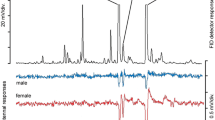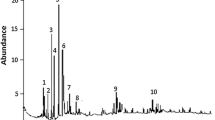Abstract
Bovine odour excites olfactory receptor(s) in a wall-pore olfactory sensillum on the anterior pit of Haller's organ in Amblyomma variegatum. Gas chromatography-coupled electrophysiology recordings from this sensillum reveal the presence of 4 active compounds in bovine odour. The two strongest stimulants were identified as 2-nitrophenol and 4-methyl-2-nitrophenol by gas chromatography-coupled mass spectrometry, and by matching electrophysiological activity of synthetic analogues. Synthetic analogues of known vertebrate-associated volatiles also stimulate other olfactory receptors in sensilla on the surface of tarsus I: a lactone receptor responding to γ-valerolactone and 6-caprolactone; different fatty acid receptor types responding best to either pentanoic acid, 2-methylpropanoic acid or to butanoic acid; three receptors responding to NH3; and one receptor responding to 3-pentanone. Gas chromatography-coupled mass spectrometry analysis of vertebrate volatiles revealed presence of a number of these olfactory stimulants in concentrates of rabbit and steer odour, i.e. 2-methylpropanoic acid, butanoic acid, 3-methylbutanoic acid, pentanoic acid, and γ-valerolactone.
Similar content being viewed by others
Abbreviations
- GC-EL:
-
gas chromatography-coupled electrophysiological recording
- GC-MS:
-
gas chromatography-coupled mass spectrometry
References
Albone ES (1984) Mammalian semiochemistry. John Wiley & Sons, Chichester New York
Altner H, Sass H, Altner I (1977) Relationship between structure and function of antennal chemo-, hygro-, and thermoreceptive sensilla in Periplaneta americana. Cell Tissue Res 176:389–405
Altner H, Routil Ch, Loftus R (1981) The structure of bimodal chemo-, thermo-, and hygroreceptive sensilla on the antenna of Locusta migratoria. Cell Tissue Res 215:289–308
Apps PJ, Viljoen HW, Pretorius V (1988) Aggregation pheromones of the bont tick Amblyomma hebraeum: identification of candidates for bioassay. Onderstepoort J Vet Res 55:135–137
Ayorinde F, Wheeler JW, Wemmer C, Murtaugh J (1982) Volatile components of the occipital gland secretion of the bactrian camel (Camelus bactrianus). J Chem Ecol 8:177–183
Barré N, Pavis C, Malosse C, Kermarrec A, Delot J, Bonijol A, Aprelon R, Rousseau L (1991) Les phéromones d'agrégation-fixation de la tique Amblyomma variegatum en Guadeloupe. Utilisation possible en lutte intégrée. Rapport IEMVT-INRA, Guadeloupe
Bernard J (1974) Etude électrophysiologique de récepteurs impliqués dans l'orientation vers l'hôte et dans l'acte d'hématophagie chez un hémiptère: Triatoma infestons. Thèse Université Rennes, France
Burger BV, Pretorius PJ, Spies HSC, Bigalke RC, Grierson GR (1990) Mammalian pheromones VIII. Chemical characterization of preorbital gland secretion of grey duiker, Sylvicapra grimmia (Artiodactyla: Bovidae). J Chem Ecol 16:397–416
Delot J (1990) Les pheromones d'agrégation-fixation chez la tique Amblyomma variegatum (Fabricius) (Ixodida): une étude en Guadeloupe. Thèse Ecole Nationale Vétérinaire d'Alfort, France
Diehl PA, Guerin PM, Vlimant M, Steullet P (1991) Biosynthesis, production site, and emission rates of aggregation-attachment pheromone in males of two Amblyomma ticks. J Chem Ecol 17:833–847
Fox GJ (1982) Potentials for pheromones in chimpanzee vaginal fatty acids. Folia Primatol 37:255–266
Gatehouse AG (1970) The probing response of Stomoxys calcitrans to certain physical and olfactory stimuli. J Insect Physiol 16:61–74
Gödde J (1989) Vibrating glass stylets: tools for precise microsurgery on cuticular structures. J Neurosci Methods 29:77–83
Goetz N, Kaba G, Good D, Hussler G, Bore P (1988) Detection and identification of volatile compounds evolved from human hair and scalp using headspace gas chromatography. J Soc Cosmet Chem 39: 1–13
Haggart DA, Davis EE (1980) Ammonia-sensitive neurons on the first tarsi of the tick, Rhipicephalus sanguineus. J Insect Physiol 26:517–523
Haggart DA, Davis EE (1981) Neurons sensitive to 2,6dichlorophenol on the tarsi of the tick Amblyomma americanum (Acari, Ixodidae). J Med Entomol 18:187–193
Hess E, Vlimant M (1982) The tarsal sensory system of Amblyomma variegatum Fabricius (Ixodidae, Metastriata). I. Wall pore and terminal pore sensilla. Rev Suisse Zool 89:713–729
Hess E, Vlimant M (1983) The tarsal sensory system of Amblyomma variegatum Fabricius (Ixodidae, Metastriata). III. Mapping of sensory hairs and evolution of the relative importance of sensory modalities during post-embryonic development. Rev Suisse Zool 90:887–897
Hopkins BA (1964) The probing response of Stomoxys calcitrans (L.) (the stable fly) to vapours. Anim Behav 12:513–524
Hribar LJ, Leprince DJ, Foil LD (1992) Ammonia as an attractant for adult Hybomitra lasiophthalma (Diptera: Tabanidae). J Med Entomol 29:346–348
Kanda F, Yagi E, Fukuda M, Nakajima K, Ohta T, Nakata O (1990) Elucidation of chemical compounds responsible for foot malodour. Br J Dermatol 122:771–776
Lacher V (1967) Elektrophysiologische Untersuchungen an einzelnen Geruchsrezeptoren auf den Antennen weiblicher Moskitos (Aedes aegypti L.). J Insect Physiol 13:1461–1470
Lees AD (1948) The sensory physiology of the sheep tick, Ixodes ricinus. J Exp Biol 25:145–207
Müller-Schwarze D, Müller-Schwarze C, Singer AG, Silverstein RM (1974) Mammalian pheromone: identification of active component in the subauricular scent of the male pronghorn. Science 183:860–862
Norval RAI, Andrew HR, Yunker CE (1989) Pheromone-mediation of host-selection in bont ticks (Amblyomma hebraeum Koch). Science 243:364–365
Norval RAI, Peter T, Meltzer MI (1992) Comparison of the attachment rates of males of the ticks Amblyomma hebraeum and A. variegatum to cattle, sheep and rabbits in the absence of aggregation-attachment pheromone. Exp Appl Acarol 15:145–152
Schoeni R (1987) Das wirtsgebundene Aggregationspheromon der tropischen Buntzecke Amblyomma variegatum (Acari: Ixodidae). Thèse Université Neuchâtel, Switzerland
Schoeni R, Hess E, Blum W, Ramstein K (1984) The aggregation-attachment pheromone of the tropical bont tick Amblyomma variegatum Fabricius (Acari: Ixodidae): isolation, identification and action of its components. J Insect Physiol 30:613–618
Steinbrecht RA (1984) Arthropoda: chemo-, hygro-, and thermoreceptors. In: Bereiter-Hahn J, Matolsky AG, Richards KS (eds) Biology of the integument. Springer, Berlin, pp 523–553
Steullet P, Guerin PM (1992a) Perception of breath components by the tropical bont tick, Amblyomma variegatum Fabricius (Ixodidae). I. CO2-excited and CO2-inhibited receptors. J Comp Physiol A 170:665–676
Steullet P, Guerin PM (1992b) Perception of breath components by the tropical bont tick Amblyomma variegatum Fabricius (Ixodidae) II. Sulfide receptors. J Comp Physiol A 170:677–685
Steullet P, Guerin PM (1994) Identification of vertebrate volatiles stimulating olfactory receptors on tarsus I of the tick Amblyomma variegatum Fabricius (Ixodidae) I. Receptors within the Haller's organ capsule. J Comp Physiol A 174:27–38
Sugisawa H (1981) Sample preparation: isolation and concentration. In: Teranishi R, Flath RA, Sugisawa H (eds) Flavor research recent advances. Marcel Dekker Inc, New York Basel, pp 15–51
Thomas G, Schomaker CH, Been TH, van den Berg MJ, Prisjs HJ (1985) Host finding and feeding in Hydrotaea irritons (Diptera, Muscidae): the role of chemical senses. Vet Parasitol 18:209–221
Thonney F (1987) Etude morphologique et structurale des récepteurs sensoriels du tarse I de la tique Ixodes ricinus L. Thèse Université Neuchâtel, Switzerland
Waladde SM (1982) Tip-recording from ixodid tick olfactory sensilla: responses to tick related odours. J Comp Physiol 148:411–418
Waladde SM, Rice MJ (1982) The sensory basis of tick feeding behaviour. In: Obenchain FD, Galun R (eds) Physiology of ticks. Pergamon, Oxford, pp 71–118
Welsh DI, Watts CD (1990) Collection and identification of trace organic compounds in atmospheric deposition from a semirural site in the U.K. Int J Environ Anal Chem 38:185–198
Zeng X-N, Leyden JJ, Lawley HJ, Sawano K, Nohara I, Preti G (1991) Analysis of characteristic odors from human male axillae. J Chem Ecol 17:1469–1492
Zeng X-N, Leyden JJ, Brand JG, Spielman AI, McGinley KJ, Preti G (1992) An investigation of human apocrine gland secretion for axillary odor precursors. J Chem Ecol 18:1039–1055
Author information
Authors and Affiliations
Rights and permissions
About this article
Cite this article
Steullet, P., Gnerin, P.M. Identification of vertebrate volatiles stimulating olfactory receptors on tarsus I of the tick Amblyomma variegatum Fabricius (Ixodidae). J Comp Physiol A 174, 39–47 (1994). https://doi.org/10.1007/BF00192004
Accepted:
Issue Date:
DOI: https://doi.org/10.1007/BF00192004




